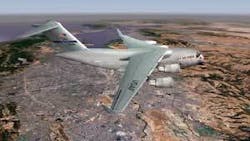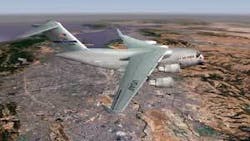By John McHale
ORLANDO, Fla. - Boeing selected the Independence IDX 3000 computer-graphics image generator from Quantum3D in San Jose, Calif., for the C-17 airlifter flight hardware simulator (FHS), company officials announced last month at the Interservice, International Training, Simulation and Education Conference (I/ITSEC 2006) in Orlando, Fla.
The Boeing FHS validates C-17 flight procedures and processes such as taxi, takeoff, approach, and landing, as well as aerial refueling, formation flying, and air-to-air target tracking tasks.
The simulator also provides evidence that basic flight-control functions are operating properly in the areas of control laws, annunciations, redundancy management, and flight handling whenever there are hardware or software changes to the FCS and Avionics due to C-17 program changes and block upgrades. The FHS also helps study flight anomalies and investigate problems.
In support of the C-17 simulator, Quantum3D will deliver the multichannel Independence IDX 3000 including a customer-specific simulation host interface. The C-17 FHS selection of Independence follows Boeing’s prior selection of Quantum3D IGs for flight and weapons-system training programs including F-15E MTC, F-15K, T-38 ATD, F-15 CTSS, F-15C DMT, F-15 RSAF, AH-64D EDS, V-22 EDS, and Boeing’s Airlift Tanker & Integration Center.
“We attribute the success of Independence to its fidelity, performance, and low cost of ownership,” says Ross Q. Smith, Quantum3D cofounder and president. Leveraging COTS components for low cost of ownership combined with efficient technology refreshment to combat obsolescence is the key to getting high-performance systems into the field as quickly as possible, he adds.
IDX 3000 is the most recent model of Quantum3D’s Independence family of commercial-off-the-shelf (COTS) image generators. IDX 3000 features technology insertion with merchant, long life-cycle, advanced NVIDIA GPU and Intel CPU technologies, along with an enhanced version of Quantum3D Mantis shader-based real-time scene management software, says Keith Kailing, vice president of visual and sensor simulation training at Quantum3D.
Introduced in late 2002, Independence uses a system-level parallel rendering architecture that combines multiple synchronized graphics processing units (GPUs) to provide low-latency, scalable, performance, image quality, fidelity, and availability, Kailing says.
Independence’s architecture isolates rapidly evolving PC components from enduring image-generator infrastructure, which enables technology insertion that lets customers swap out PC components with newer technology without affecting application software and database compatibility.
Independence customers can upgrade their systems and improve performance and fidelity as new PC technology becomes available, while avoiding end-of-life (EOL) problems and other obsolescence issues, Kailing says. Since its inception, Independence technology insertion has accommodated four generations of CPU upgrades and six generations of NVIDIA GPU upgrades that began with the NV20 GPU in the IDX 1000 and now employs the G71 GPU running at 3.4 GHz in the IDX 3000, he adds.
The real key to the COTS development is the ability to scale the system, Kailing says. The modular architecture has enabled what once took racks and racks of computers can now be done in just a few, he adds.
The Mantis scene-management software offers a powerful, yet flexible Vis/Sim environment based upon plug-in technology, which is unlike many other solutions, Quantum3D officials say. It comes equipped with a suite of standard features that support communications functions, peripheral devices, displays, and multi-channel synchronization.
The Mantis architecture supports traditional high-end IG features, including special effects, sensors, weather, and lighting, along with mission functions such as height-above-terrain and line-of-sight intersection testing. Features such as multi-head data and frame synchronization and dynamically paged terrain are all standard capabilities of Mantis.
Additional capabilities include time-of-day and weather effects. As Mantis is designed to work with plug-ins that offer additional capabilities, its features are easily extended. viXsen, the first plug-in, offers real-time sensor effects that are correlated with the out the window view.
Quantum3D develops and markets real-time, open-architecture image generators, embedded visual-computing systems and subsystems, development software, and support services for the visual and sensor simulation and training (VSST) and embedded visual computing (EVC) markets.
For more information about Quantum3D, visit www.quantum3d.com.




